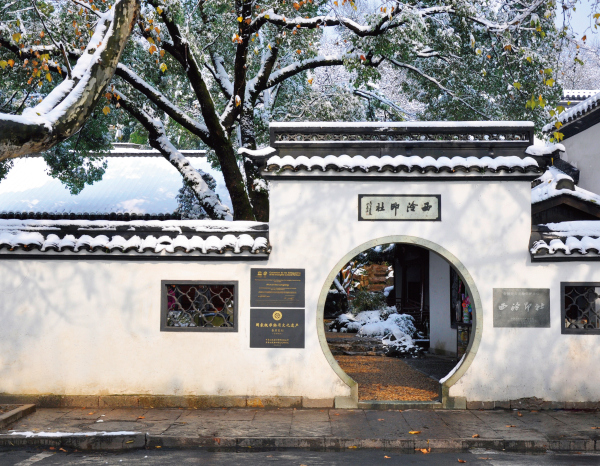
A view of the moon gate of Xiling Seal Art Society on a snowy day
The Xiling Seal Art Society is famed for its location on the scenic West Lake, its international influence, its focus on seal art which goes back to more than 2,000 years ago, and its cultural essence and value.
The society is unique because it has masters whose importance in the history of Chinese art is indisputable; it exists as a landmark of history and culture for more than 100 years; and it is part of the aesthetics of the West Lake, which is a site of UNESCO world cultural heritage.
The society stands for professionalism. Of all the things that have come down to us from very ancient times, seals and seal carving represent history, ancient systems, ancient artifacts, and ancient texts and scripts and calligraphic styles. Moreover, they convey the sentiments of literati masters. Seal studies in the ancient times were principally about history and archaeology and in modern times are essentially about art and aesthetics.
Since the Ming Dynasty (1368-1644) up to present day, Jiangsu and Zhejiang in the south of the Yangtze River Delta have produced seal artists whose names are in the history of Chinese art. Though the region is far from the cradles of ancient Chinese dynasties in the Yellow River basin, seal artists in the region rediscovered the glory and splendor of the ancient calligraphy and seal engraving, and carried on the calligraphy and seal-carving tradition of the Qin (221-207BC) and the Han (206BC-220AD) dynasties. The seals created by these men of letters including painters, calligraphers, and poets express idiosyncrasies, sentiments, thoughts, and ideals. It is in their hands that seal studies have become an academic discipline and innovative cultural undertaking. The society’s professionalism seen in seal studies is internationally recognized.
The seal art upheld by the society is not an abstract conception. It is real and it is huge. The Beijing 2008 Olympics emblem, unveiled in 2003, was a crystal-clear Chinese seal carved on a jade stone. The main part of the official emblem, a red dancing figure, resembles the Chinese character "京" (Beijing, capital), its free-style strokes symbolizing the energetic and open city of Beijing. The design well represents the spirit, characteristics and verve of the Chinese culture. Even “Beijing 2008”, the central part of the emblem between the seal above and the five rings underneath, is written in the calligraphic style with a brush pen, which also embodies seal art.
The 117-year history of the Xiling Seal Art Society abounds with culture. The society is a distinct cultural undertaking. Located in Hangzhou, capital city of the province and therefore the center of all things of the province, the society has seen the end of the Qing Dynasty, the birth of the Republic, the decades of political and military chaos, the wars, all kinds of tumults after the founding of the People’s Republic of China, its comeback and prosperity since the late 1970s. As a society of art, it is unique not only in Zhejiang but also in the entire country. The chronicle of the society details various events. Memoires and short histories penned by members of the society at different periods of the 117-year history keep so many historical figures and historical moments alive.
The physical beauty of the society on the West Lake testifies to the significance of the cultural institution. It is said that Hangzhou is the center of Zhejiang, the West Lake is the heart and soul of Hangzhou, and the Solitary Hill is the center of the West Lake. The nice reasoning, made jokingly, ends with this, leaving one to conclude that the society is one of the best cultural attractions of the lake zone. The venue snuggles comfortably at the foot and perched on the western end of the Solitary Hill. It is like a garden. The garden is composed of various ancient structures, nothing looking grand and everything seeming miniaturized. Yet it is complete, full of poetic couplets as well as images and inscriptions carved on rocks. The Xiling Society looks like a museum, suggesting a physical and tangible mix of cultural space and time.
Shortly after the establishment of the society, Wu Changshuo and four founders identified the society’s mission: preserve the inscriptions on ancient bronzes and stone tablets and promote seal studies. No other cultural institutions in China have a similar mission.
Xiling Seal Art Society preserves ancient inscriptions on bronzes and stone tablets. There were two important peaks in the history of studies of the inscriptions on ancient bronzes and stone tablets. The studies first flourished in the Song Dynasty (960-1279), promoted by Ouyang Xiu, Zhao Mingcheng and his wife Li Qingzhao. The second peak appeared in the Qing Dynasty (1644-1911) when scholars worked as archaeologists and studied ancient texts copied from bronzes and stone tablets. When the modern western-styled education system was established in China, the studies of inscriptions on bronzes and stone tablets, first of all, were partly replaced by archaeology and other disciplines such as studies of the ancient philology, studies of inscriptions on ancient bronzes and stone tablets, studies of ancient artifacts, ancient literature, textual criticism and research.

Not far from the moon gate entrance is this introduction carved on a piece of stone to Xiling Seal Art Society on the compound.
Xiling Seal Art Society promotes seal studies. The society has wanted to promote seal studies for a long time. Sha Menghai (1900-1992), who headed the society from 1979 to 1992, set up the aim for the society to be the international center for seal studies. The society now holds seminars and workshops on various subjects including inscriptions on ancient bronzes and stone tablets, rubbings of stone tablets, seal prints, and ancient government seals. In addition to such traditional subjects, scholars and artists of the society have broadened their studies to graphic seals, non-Chinese-character seals, international seals, seals used by minorities in China. History is a focus of seal studies, including the history of the society and its members in the early decades, important seal artists in history, scholars and collectors of inscriptions on ancient bronzes and stone tablets in history, the history of seal prints in China, etc.
Painting and calligraphy are an essential part of the society’s mission now. In the early years of the society, the organization’s mission didn’t include painting and calligraphy. In old days, scholars were versatile: they painted and wrote calligraphy, they composed poems and penned essays. If they passed imperial examinations, they were appointed to government positions. In modern times, art education isn’t as comprehensive as it was in the past. In the modern education system, an artist may be a master painter, but his calligraphy can be mediocre, and very probably he can’t even be called a poet or an essayist. The society now goes against this intricate array of academic disciplines. It wants members to know more about other disciplines and wants its members to be all-rounded artists.
